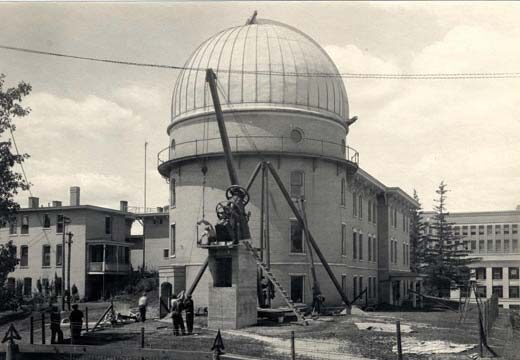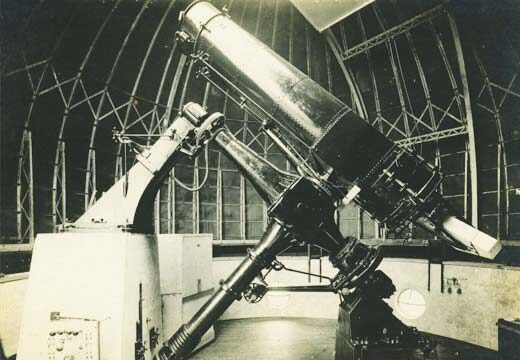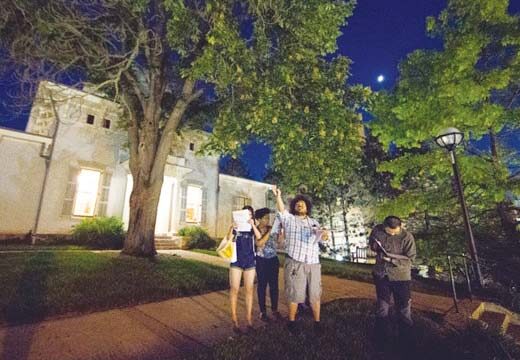Star power
The Detroit Observatory, U-M’s second-oldest campus building and the state’s first observatory, is getting an upgrade. The $10-million project will deliver improved accessibility and greater connectivity, as well as new teaching and reception areas and facilities for storage and catering. The Detroit Observatory opened in 1854.
-
Starry night
The renovation project includes significant earthwork and specialized footings and foundations to protect the historic building and support the below-grade addition and landscape above. The scope of the project also includes the architectural, electrical, and mechanical work necessary to complete the improvements. (Image: U-M’s Bentley Historical Library.)
-
Tappan’s vision
U-M President Henry Philip Tappan spearheaded construction of the Detroit Observatory. In his view, a great observatory would anchor the new scientific curriculum he was planning. He ordered a Meridian Circle telescope from the finest optical-instrument makers in the world, Pistor & Martins of Berlin. Visiting Berlin in 1853, Tappan asked astronomers of the city’s Royal Observatory, including the assistant director, Dr. Franz Brünnow, to supervise the telescope’s construction and testing. This photo of the observatory is dated 1924, and shows workers installing a telescope. (Image: U-M’s Bentley Historical Library.)
-
Meridian Circle
The extremely precise Pistor & Martins Meridian Circle could provide the state’s railroads with a commodity essential to preventing wrecks and delays: precise measurement of the time. Staff at the observatory sent regular signals to the Michigan Central Railroad. (Image: U-M’s Bentley Historical Library.)
-
Open wide
In the mid-to-late 19th century, the most extraordinary stargazing took some work. To see stunning detail of the moon, Jupiter, Saturn, and other celestial bodies, one had to reach up, grab thick ropes, and pull. The ropes engaged wall-mounted gears. Once engaged, they rotated and positioned the track-mounted dome of the observatory. This allowed the telescope to point through the “shutter” opening and into the night sky. This overhead photo shows an addition, built in 1908, which was torn down in 1976. In this undated, vintage shot, the observatory and its addition are framed by dirt roads. (Image: U-M’s Bentley Historical Library.)
-
Reflections
Between 1863-77, James Craig Watson, a former student of Brunnow and second observatory director, discovered 21 asteroids in his research. Much later, the observatory acquired this instrument, which is a 37.5-inch reflecting telescope, with spectrometer. (Image: U-M’s Bentley Historical Library.)
-
19th-century impressions
Jasper F. Cropsey painted the Detroit Observatory in 1855. The observatory is so named to recognize the Detroit philanthropists who raised the funds for initial construction. (Image: U-M’s Bentley Historical Library.)
-
View from the heavens
After its glory days of the late 1800s, by the 1920s and ’30s the University had established more modern observatories. Growing light pollution from burgeoning adjacent development affected the telescope, and the facility was used less and less. In the mid-1990s, then-U-M President James Duderstadt and his wife, Anne, initiated efforts to preserve it. (Image: U-M’s Bentley Historical Library.)
-
Waiting for night to fall
In this 1940 photo, workers can be seen on the exterior dome. (Image: U-M’s Bentley Historical Library.)
-
Take a look
A stargazer looks at the moon through the Fitz telescope’s eyepiece. The refracting telescope was once the third-largest in the world at nearly 17 feet. (Image: Eric Bronson, Michigan Photography.)
-
Night magic
The observatory building and instruments were restored in 1996-99. During the International Year of Astronomy in 2009, the first public viewings were scheduled, and they became a regular feature the following year. Here, viewing night attendees consult star maps to continue their star-viewing experience outside the observatory. (Image: Eric Bronson, Michigan Photography.)











